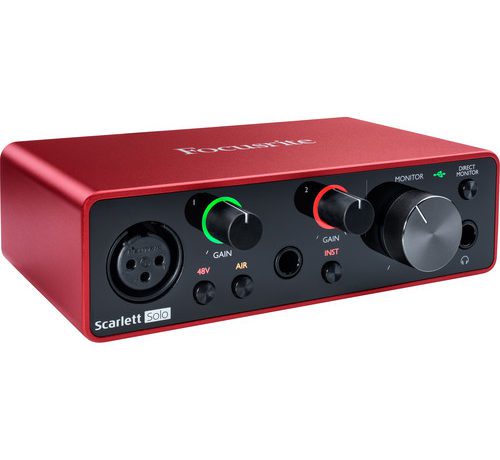Focusrite Scarlett Solo 3rd Gen review
Focusrite Scarlett Solo 3rd Gen review
The Focusrite Scarlett Solo 3rd Gen is a no-brainer for Beginning-level recording Studios. The unit’s amazing recording quality, solid preamps, and agreeable price point set the Scarlett Solo at the top of its class. I just wish it had MIDI I/O.
PRO’S
- Great recording quality
- Air mode
- Affordable
CON’S
- No MIDI I/O
I/O and controls
On the front panel, you’ll find an XLR input as well as a TRS input. The XLR input is equipped with both 48 V phantom power as well as Focusrite’s signature Air mode, and the TRS-in has a switch to toggle between instrument and line level.
Each channel has an illuminated LED gain dial, which changes from green to red when the signal begins to peak. The same LED illumination is utilized in every switch to signal when they are being engaged.
Located on the right of the front panel is the master control dial, as well as a 1/4-inch headphone output, and a direct monitoring switch.
The rear panel of the Scarlett Solo 3rd Gen interface is simple, featuring only a USB-C port and two balanced studio monitor outputs.
Recording quality
The Focusrite Solo Consist of A/D converter captures audio at 24-bit depth and has a maximum sample rate of 192 kHz. It also has a fairly respectable dynamic range, reported at 111 dB, 110.5 dB, and 110 dB for the XLR-in, line input, and instrument input, respectively.
Preamps
As a custom, the unit features Focusrite signature Air mode on the preamp for the XLR input. While you may already be familiar with it, the preamp’s design was custom-made by Focusrite founder, Rupert Neve, sometime in the mid-80s. The effect essentially sets a filter on your preamps which boosts the mids and highs of your recording signal, adding a bit of life and brightness while you track.
Software bundle
Upon purchasing the Scarlett Solo, you’ll receive access to Ableton Live Lite, plugin collection, Hitmaker Expansion Bundle, as well as a three-month subscription to Avid Pro Tools. All in all, not too shabby.
Focusrite Scarlett Solo vs PreSonus AudioBox USB 96
Pros of PreSonus AudioBox USB 96 Cons of PreSonus AudioBox USB 96
- Two combo inputs A/D resolution of 24-bit/96 kHz
- MIDI I/O
- Direct monitoring control knob
Focusrite Scarlett Solo vs Behringer UMC202HD
In the case of opting for the UMC202HD, it has two XLR/TRS combo inputs and has all the same features and performance capabilities as the Scarlett. On the other hand, it’s a Behringer unit. Pick your poison.


